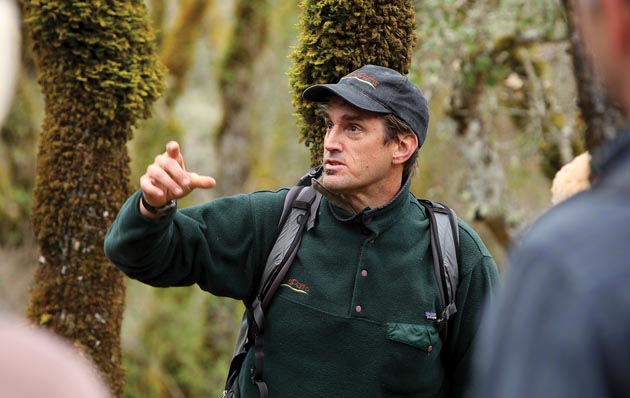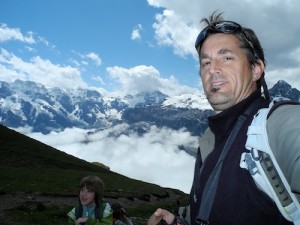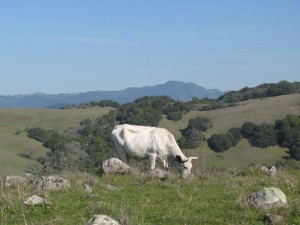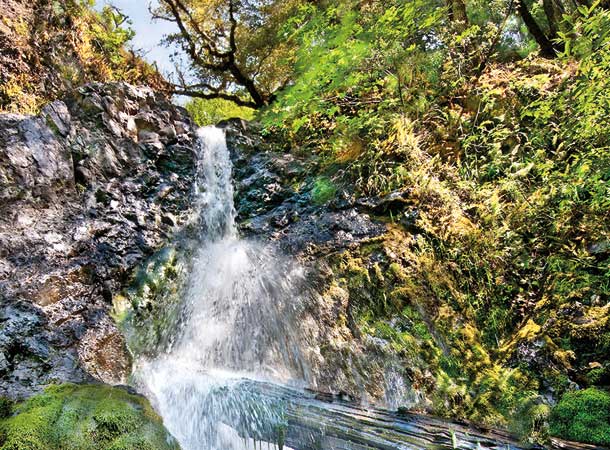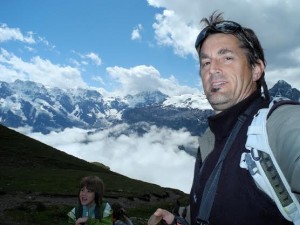It’s sometimes hard to tell what Craig Anderson loves more: land, people, music, outdoor adventure, or his 29-year-old Toyota pickup. That’s because whatever he’s doing at any particular moment, he’s doing it with great passion, keen intention, and a big heart. So it’s no surprise that in the 17 years Craig has directed LandPaths, it has become one of the most dynamic, innovative, and effective–and eclectic–conservation organizations in the Bay Area, pioneering new and fun (never forget the fun part) ways to connect people to land … and perhaps save the world in the process. Anderson is the winner of Bay Nature’s 2014 Conservation Action Award.
AG: LandPaths seems to be the intersection of food, nature, and people. What’s the importance of that triangle?
CA: We have largely been disconnected from land in the technology-fixated Western Hemisphere. LandPaths’ job is to reestablish the connection of people and place. That means wildlands, but it also includes participatory agriculture. The ability to connect over land gives us a greater sense of community wholeness and integrity.
AG: LandPaths connects people to land in Sonoma County. As state and county programs lost funds and the capacity to operate and steward open space, your organization developed a model called “people-powered parks.” What is your definition of a people-powered park?
CA: People-powered parks are an idea that is still evolving on each individual property. Our organization comes to a piece of land not with a plan but with a purpose that involves deep participation, open dialogue, and inclusivity. Exclusion is subtle. It’s very common in the community-based conservation field to bring people to our mission and show them what we do, instead of helping them show us how they would express our mission. That’s a big difference. A people-powered park is also about ownership. As one of my former staff members said about Bayer Farm, “We offer the dignity of responsibility.”
When the Grove of Old Trees in Occidental opened for public access in 2000, it was the first privately owned preserve in Sonoma County that was free and open to the public every day of the year from dawn to dusk. Our staff manages the grove in a strong partnership with Friends of the Grove, or FOG. They fundraise, walk the trail, put chips on the trail, mend fences, and talk to neighbors. They are there every single day and what they provide is beyond what can be valued.
AG: LandPaths has had success doing something that other organizations talk about but don’t manage to do: earn the participation of the entire community. How did you do it?
CA: Twelve years ago, assistant director Lee Hackeling and I started to ask that question and got a small grant from the Coastal Conservancy and the Bay Area Open Space Council. Our first attempt was an outing for the Spanish-speaking community. We hired a guide, aired PSAs on a Spanish-language station, and advertised in a bilingual paper. We got three people on the hike. I was crestfallen. We went back to the drawing board and ultimately figured out that we not only needed to change the way we communicated our programming, we needed to change our programming. Frankly, taking a nine-mile hike on a new piece of open space with a naturalist pointing out oak galls doesn’t necessarily appeal to everyone. We also learned that we needed to change our organization’s face to reflect our community. Now we have three people on a staff of fifteen who are bilingual, bicultural, and Mexican-born. They are phenomenal staff members. Diversity in Sonoma County is not just the Latino–European–Pan Asian community. It’s also people from a traditional agricultural and ranching background; it’s vintners; it’s Gen X and Gen Y; it’s families; and frankly, it’s urbanites who are so busy trying to keep up in this world that their understanding of local economy and food has not expanded beyond big-box stores. We’re not happy at LandPaths until we’re able to reach everybody.
AG: How do you see yourself as a leader in this organization?
CA: When I was a rafting guide, in a previous life chapter, I found that there were times to let the people in the boat paddle so that they could learn about currents and eddy lines and underwater obstructions. And there were other times to say, in a clear and hopefully calm voice, “All back!” or “Back left! Now back right!!” Because if you didn’t, you’d flip and swim. I’ve been at LandPaths for 17 years now, and these days my leadership role is more to inspire our staff, volunteers, and community to incubate their own ideas and projects.
Leadership in 2014 also requires that I not just look at LandPaths’ mission, but that I work with our organization to heal the wounds in our community. That includes the melting of ice sheets up north where the polar bears live. That includes the death of Andy Lopez [the 13-year-old boy fatally shot by a Sonoma County sheriff’s deputy in Santa Rosa in October 2013], and the seeming alienation that leads young men to commit acts of violence. Those of us who work for nonprofits and community-based organizations need to follow our missions, but we also need to figure out how our mission can help bind the wounds of our communities. I look at cyberbullying, school shootings, and juvenile obesity as conservation problems. I believe that the great pain and suffering in our communities and in our civilization can be addressed if we do our work better, which is to connect people to land, culture, and hope. That, to me, is true leadership.
AG: What’s more fun? Fishing from your kayak on the Sonoma Coast; playing in your band, Cahoots; or attending a LandPaths board meeting?
CA: They’re all fun because they’re all productive. Even when a meeting is hard and even when the seas are choppy, I love my work. That includes going to board meetings and it includes paddling in my kayak in 25-knot winds when I feel I’m going to die in order to pick up a crab pot.
AG: What keeps you up at night?
CA: Thinking about how our organization could be better. It’s a sacred act for someone to give you land. LandPaths now owns four pieces of land. Families dearly loved all four of them, and I stay up at night thinking about how we will care for, financially sustain, and provide programs for every preserve. I actually think right now is the most exciting time to be alive. I believe we’re living at the crest of a wave where we can help turn our civilization toward living in greater harmony with not only the land but with each other. I’m sure by the time I go to the convalescent home — if I’m lucky enough to live that long — the sides of buildings will be gigantic vertical kale farms. There’s going to be the weirdest stuff. I just think it’s a really exciting time to be alive.

